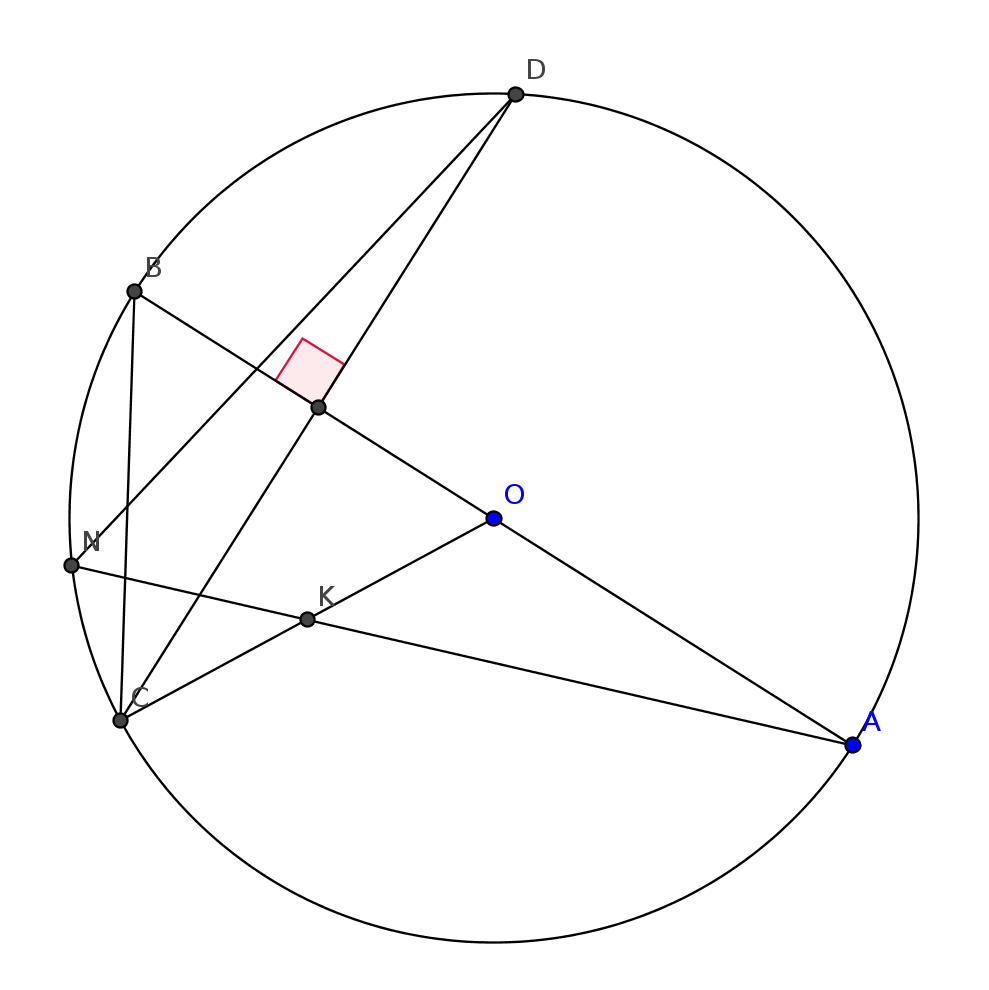Geometry question

Pure geometry question
is a chord of circle with centre .
diameter bisecting it.
drawn and its midpt
drawn intersecting circle at
Prove that bisects
No vote yet
1 vote
Easy Math Editor
This discussion board is a place to discuss our Daily Challenges and the math and science related to those challenges. Explanations are more than just a solution — they should explain the steps and thinking strategies that you used to obtain the solution. Comments should further the discussion of math and science.
When posting on Brilliant:
*italics*or_italics_**bold**or__bold__paragraph 1
paragraph 2
[example link](https://brilliant.org)> This is a quote# I indented these lines # 4 spaces, and now they show # up as a code block. print "hello world"\(...\)or\[...\]to ensure proper formatting.2 \times 32^{34}a_{i-1}\frac{2}{3}\sqrt{2}\sum_{i=1}^3\sin \theta\boxed{123}Comments
This problem is based around this property for similar triangles: Corresponding elements in similar triangles are also "similar". This will be disguised in the following proof(more like a sketch actually):
Denote DN∩BC=X
First note that △COA∼△CBD. By properties of circles: ∠CDX=∠CAK,∠BDX=∠OAK, using this we can prove △CDX∼△CAK,△XDB∼△KAO, which gives: CKCX=CACD=OABD=OKBX ⇒BXCX=OKCK=1 ⇒CX=BX. Q.E.D
Log in to reply
Thank you very much. very nice solution
(y) Nice
Here goes my solution : Denote {M}=BC∩NK then we have NCKM is concyclic (since ∠KNM=∠OBC=∠KCM : I skipped a few details here, you can verify them if you will). Using the angle chasing technique, one has ∠NKM=∠NCM=∠NAB⟹KM∣∣AB. Now, consider the triangle OBC with KM∣∣OB and K is the midpoint of OC, these lead to the fact that M being the midpoint of BC as expected.
Log in to reply
Elegant solution
I will provide another solution just for fun. This one I'll use something called Harmonic division, for those that are unfamiliar just google, there's a lot of papers written on this wonderful topic. Here is the 2nd proof:
Keeping DN∩BC=X, we denote AK∩BC=M.
If we want to prove X is the midpoint of BC, we just need KX∥BO. Since O is the midpoint of AB, we now just need to prove K(X,O;B,A) is a harmonic pencil ⟺ so is K(X,C;B,M) ⟺ so is N(X,C;B,M) ⟺ ACBD is a harmonic quadrilateral which is true since BD∗CA=DA∗BC. Q.E.D
Log in to reply
I won't explain the notations here, since it's pretty "universal" in projective geometry. Again, I encourage those that have never heard of Harmonic divisions to read about it.
Although the words "projective geometry" might sound intimidating to some of you, in terms of just harmonic division, I think we can keep everything Euclidean by just knowing the fact that cross-ratios are possible due to the ratios of trig angles etc. I know these make no sense but you will know what I mean once you read about it....
Log in to reply
Thanks! :)
These are cross ratios right? To my knowledge, I think the way you do it is wrong? Because you stated K(X,O;B,A) is a harmonic pencil, but they are not concyclic or collinear, can you do that? The part from K(X,C;B.M) to the ACBD as a harmonic quad is correct, but then when you project the line XCBM, to the line OBA, through point K, you did not project X. Cheers!
Log in to reply
Ok, I think I see the confusion here. Well, KX is considered to intersect AB at the point at infinity on AB, which is something new introduced in projective geometry. Despite that though, it can be checked that the cross-ratio(trig ratio) isn't affect when you have parallel lines.
Log in to reply
Alright I remember now because given two points, if the midpoint divides the segment internally, the point at infinity on that line divides it externally with the same ratio, 1. So in K(X,O;B,A), you actually meant K(KX∩AB,O;B,A), where KX∩AB is actually point at infinity, and therefore the two lines are parallel. Thanks for that!
Bonus point to proving AN trisects BC, and another bonus point to proving DN trisects BO!
Log in to reply
Both are trivial using Menelaus' theorem.
Log in to reply
Yes menneeaus will prove it
Well using your notation I just play around with the harmonic conjugates (X,C) and (B,M), so it's pretty much the same thing with Menelaus'.